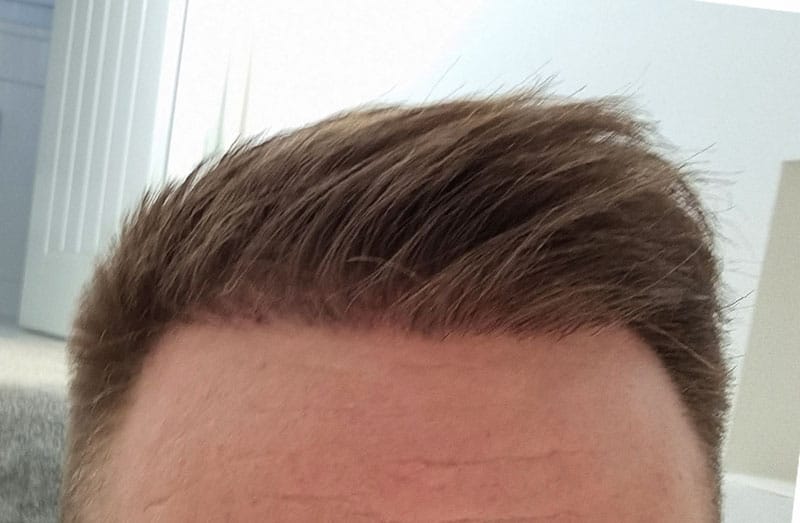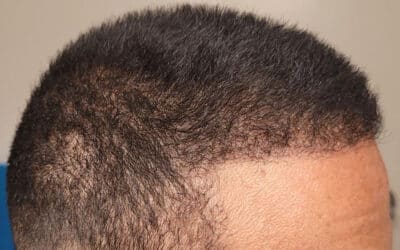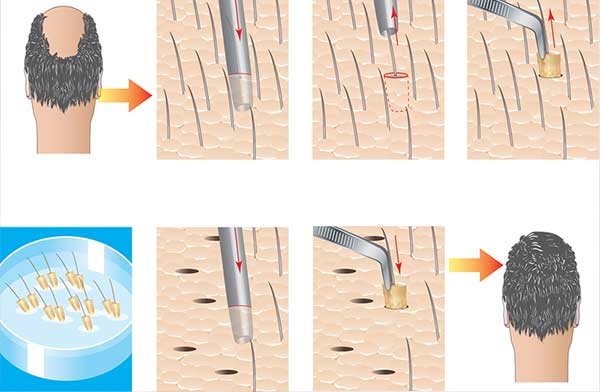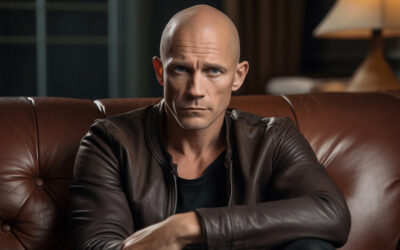Hair loss can be a distressing experience, especially for African American men. The unique texture and growth pattern of their hair requires specialised treatments. Among the most effective solutions is the Black Male FUE Surgery, a procedure tailored to address the specific needs of black men, ensuring natural and lasting results.
Causes of Hair Loss in African Americans

African American men and women often experience hair loss due to common reasons like male and female baldness. Prolonged hairstyles such as weaves and braids can also lead to traction alopecia. While various treatments are available, hair transplantation remains the most permanent solution.
- Male Pattern Baldness: This is a genetic condition that results in receding hairlines and thinning hair on the crown.
- Female Pattern Baldness: Women may experience overall hair thinning, especially at the crown.
- Traction Alopecia: Prolonged tension on the hair, often from hairstyles like tight braids, can lead to this condition.
- Non-Surgical Solutions: Topical treatments and laser therapy can promote hair growth and reduce hair loss.
- Hair Transplantation: This is the only permanent solution to most types of hair loss.
- Hair Care Practices: Proper hair care can prevent certain types of hair loss.
How Hair Transplants Work
Hair transplants are surgical procedures designed to minimise the appearance of hair loss and promote new hair growth. Hair Transplants offers two primary surgical procedures: follicular unit extraction (FUE) and follicular unit transplantation (FUT). Both methods involve transplanting hair from a donor area to the recipient area.
- Donor Area: This is the part of the scalp where hair is taken for transplantation.
- Recipient Area: The area where the hair is transplanted to.
- Natural Growth Pattern: Transplanted hair is placed following the scalp’s natural growth pattern for a natural look.
- Hair Grafts: These are the units of hair that are transplanted.
- Extraction and Implantation: The process involves extracting hair grafts and implanting them in the desired area.
Follicular Unit Extraction (FUE) Procedure

The FUE technique harvests individual hair follicles, a method that surpasses older techniques with more natural results and minimal scarring.
- Individual Extraction: Instead of removing a strip, each hair follicle is taken from the donor area.
- Follicle Units: Individual follicles ensure precise placement in balding regions.
- Natural Appearance: Careful transplantation promotes an organic look, maintaining the hair’s natural growth pattern.
- Donor Site: Various areas of the scalp can serve as donor sites, allowing flexibility in extraction.
- Recovery: Quicker than FUT, patients often return to normal routines within a week.
- Scarring: Virtually invisible scarring with tiny extraction sites that heal rapidly.
Follicular Unit Transplantation (FUT) Procedure
The FUT method involves removing a strip of tissue from the scalp containing permanent hair follicles. This donor strip is then dissected into follicle groupings called units. These units are then transplanted into the recipient site, ensuring natural-looking results and maximum coverage.
- Strip Extraction: A strip of hair-bearing skin is removed from the donor area.
- Follicle Units: The strip is dissected into individual or grouped hair follicles.
- Natural Appearance: Careful placement ensures the transplanted hair blends seamlessly.
- Donor Site: Typically, the back of the scalp serves as the donor site due to its resistant nature to balding.
- Recovery: Due to the strip extraction, the FUT method might have a slightly more extended recovery period.
- Scarring: A linear scar is left at the donor site, which can be concealed with surrounding hair.
Experience Matters in Hair Transplants
When considering hair transplant results, the surgeon’s experience is crucial. Look for the physicians who have performed numerous hair transplants for African American patients, understanding the unique characteristics of African American hair. Their expertise ensures optimal density and the appearance of results.
| Factor | Importance |
| Expertise | Predict and achieve desired outcomes. |
| Unique Hair Characteristics | Understand and cater to the specific attributes of African American hair. |
| Client Testimonials | Gain insights into the surgeon’s expertise through past patient experiences. |
Am I a Good Candidate for a Hair Transplant?

Determining candidacy for a hair transplant is crucial for achieving desired results. The best candidates are those suffering from androgenetic alopecia or pattern hair loss. Individuals need sufficient hair at the donor site, and consultations help assess the procedure’s suitability for each person.
- Pattern Hair Loss: Those with hair loss at the top but substantial hair at the back are ideal candidates.
- Traction Alopecia: Individuals with hair loss due to tight hairstyles can benefit from transplants.
- Donor Hair Quality: Good quality hair at the donor site is crucial.
- Consultation: A thorough assessment determines the best procedure and expected outcomes.
- Gender Considerations: Both men and women can benefit from hair transplants, with procedures tailored to each.
- Hair Loss Pattern: The established pattern of hair loss helps plan the transplant.
What to Expect During the Recovery Process?
Recovery from a hair transplant requires careful aftercare. FUE and FUT procedures require specific post-operative measures to ensure the best results. The recovery process is vital for a successful outcome, from protecting the grafts to managing discomfort.
| Recovery Aspect | Description |
| Immediate Aftercare | The treatment area might feel tight or tender post-procedure. |
| Activity Restrictions | Avoid strenuous activities and hair washing initially. |
| Graft Shedding | Transplanted grafts may shed after 1-2 weeks, signalling new hair growth. |
Non-Surgical Alternatives to African American
Hair Transplants While surgical hair transplants offer permanent solutions, non-surgical alternatives are available. Low-level laser therapy, for instance, uses light wavelengths to stimulate hair growth. Additionally, products containing finasteride or minoxidil can effectively address hair loss.
| Alternative | Description |
| Low-Level Laser Therapy | Promotes hair growth by stimulating blood circulation. |
| Finasteride | Prevents testosterone conversion, addressing androgenetic alopecia. |
| Minoxidil | The topical solution increases blood flow to the scalp. |
Preparing for a Hair Transplant Procedure
Before undergoing a hair transplant, specific preparations are essential. Providing a complete medical history and discussing medications helps ensure a safe procedure. Additionally, measures like scalp moisturising and avoiding direct sunlight can aid in achieving the best results.
- Medical History: A comprehensive history helps in assessing any potential risks.
- Medication Review: Some medications might need to be paused before the procedure.
- Scalp Care: Moisturizing and massaging the scalp can enhance the procedure’s success.
- Sun Protection: Direct sunlight should be avoided, or a head covering should be worn.
- Consultation Insights: The pre-procedure consultation provides tailored advice and preparations.
- Mental Preparation: Understanding the procedure and setting realistic expectations is crucial.
Black Male FUE Surgery has revolutionised the approach to hair transplantation for African American men. Its tailored technique and focus on the unique attributes of black male hair promises natural-looking and durable results. As hair loss solutions continue to evolve, this procedure remains at the forefront, offering hope and confidence to many. If you’re considering a hair transplant tailored to your unique needs, don’t wait any longer.
To ensure your ease of mind, you can view our customer recommendations HERE. Furthermore, you can also see our Google reviews and Yelp reviews. We can’t wait to help you start restoring your lost hair.
Book a Consultation with our Hair Transplants Los Angeles experts and take the first step towards restoring your confidence and youthful appearance.
FAQs about Black Male FUE Surgery
Black Male FUE Surgery is a specialised hair transplant procedure for African American men. It focuses on the unique characteristics of black male hair, ensuring natural-looking and effective results.
Unlike generic hair transplant methods, Black Male FUE Surgery considers African American hair’s distinct texture, curl pattern, and growth direction, ensuring that the transplantation process and results are optimized for black men.
Black Male FUE Surgery uses local anesthesia, so most patients find hair transplants minimally painful. During and after the procedure, discomfort is often reported as minimal, making the fear of pain largely unfounded.
The recovery period varies among individuals, but most patients can return to regular activities within a week. Following post-operative care instructions is essential to ensure optimal healing and results.
Typically, the transplanted hair may shed initially, which is a normal part of the process. New hair growth usually begins around three months post-surgery, with significant improvement noticeable by six to nine months.












